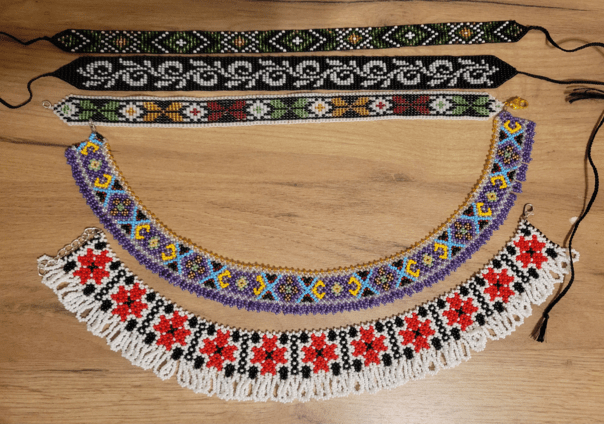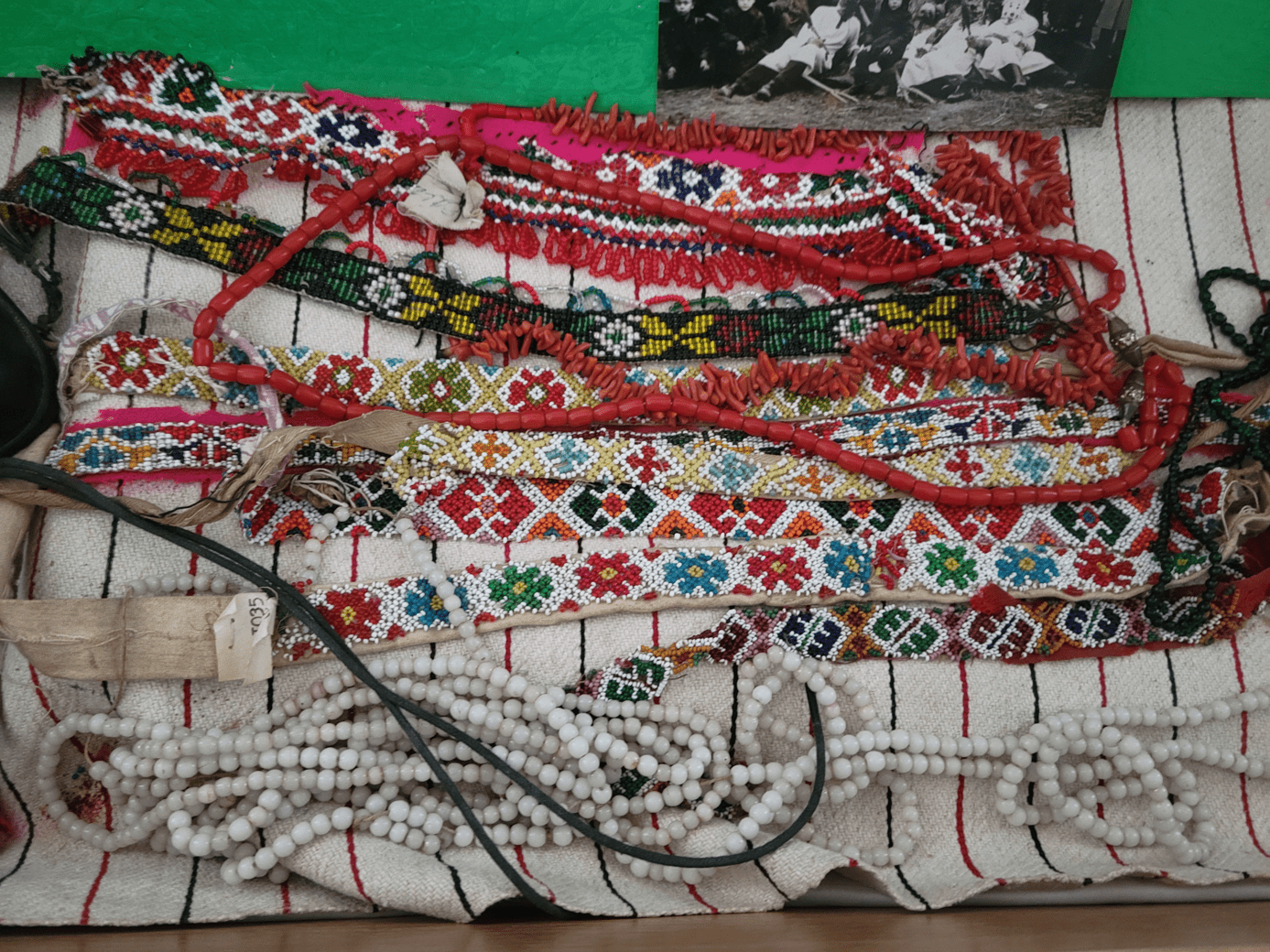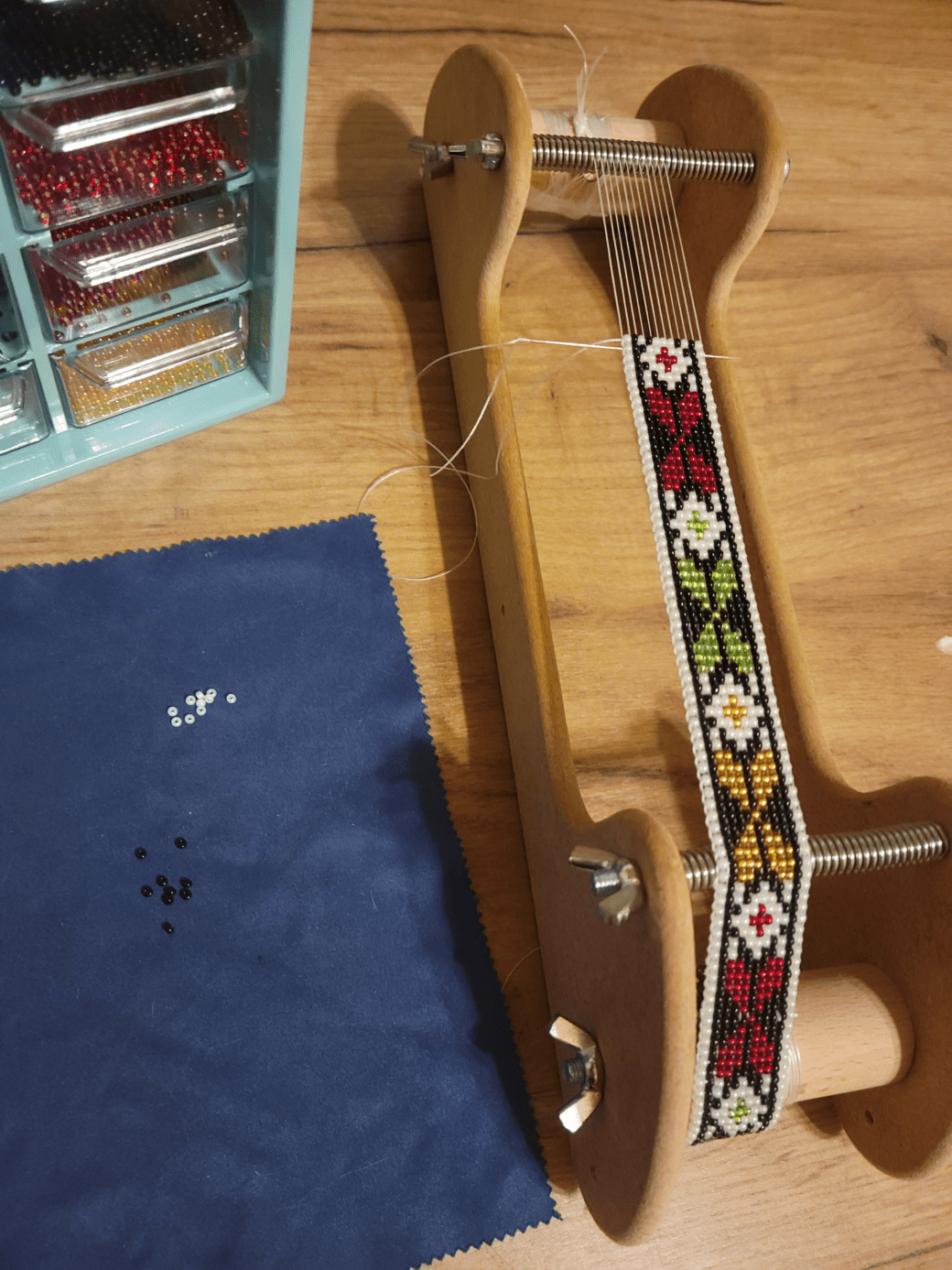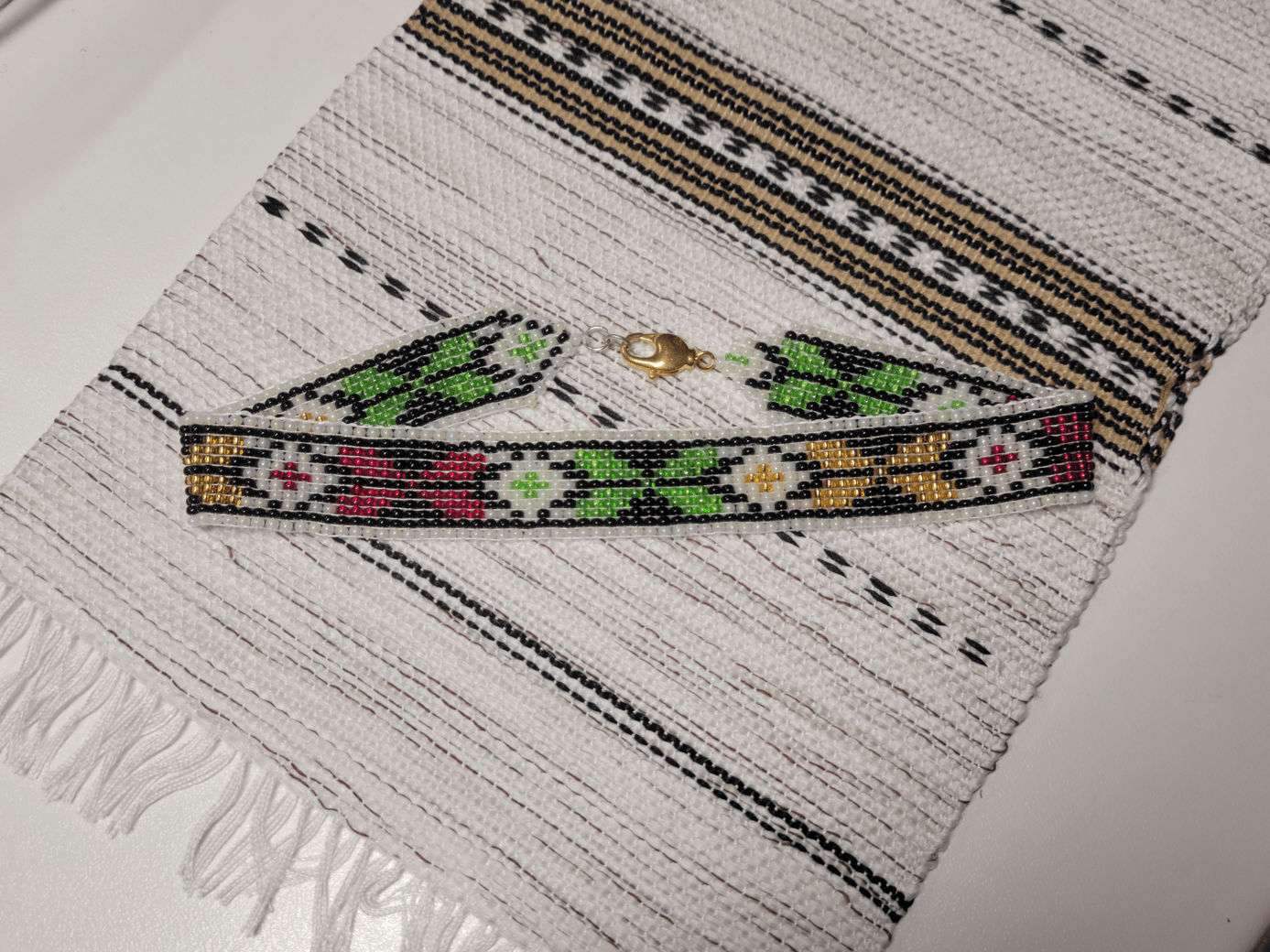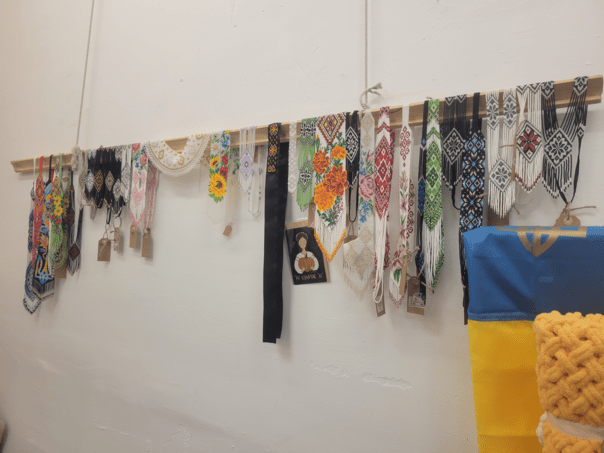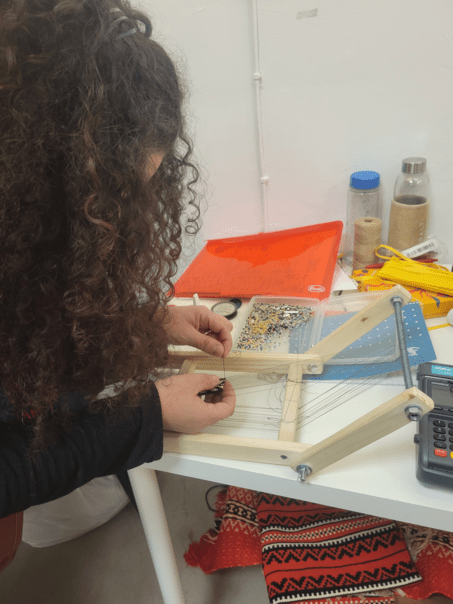Silyanka
Out of all the elements of the typical Sniatyn folk costume, the silyanka (plural: silyanky) was the most mysterious for me at the outset. This page outlines how I discovered them and went on to make my own silyanka.
The silyanka, briefly, is a beaded necklace that sits closely along the neck (a choker), though they have also been used as headbands. Silyanky are quite colorful and typically feature geometric patterns, though floral patterns and other contemporary designs are also common nowadays. We’ll get more into the specifics of the silyanka below.
In contrast to embroidery and various other traditions, the silyanka has only survived very sporadically among the Ukrainian diaspora in North America. Even when looking at diaspora dance troupes like Desna – which typically wear other well-known elements of national Ukrainian costume, such as red dancing boots, vyshyvanky, coral necklaces, and even the keptar (sheepskin vest common in Hutsul / Prykarpattia dress) on occasion – the silyanka tends to be absent. While there has been more push in the past couple of decades to resume beadwork among the diaspora, especially with access to the internet, it’s still not widespread. Why the skill isn’t often found within the diaspora at large is beyond me (whether it be that the patterns were lost or because the diaspora now veers toward Central/Eastern Ukrainians, who don’t have this tradition nearly to the same extent as the West), but it does mean that learning more about the silyanka and how to make one was daunting from the start.
Regardless, falling down that rabbit hole of research was not a priority when I began this project. I’ve never really been interested in jewelry-making or beading, especially since I don’t wear a lot of jewelry myself. And besides, other necklaces always seem to get buried under the coral ones, at least in the Sniatyn region. Why bother to look further? My original plan had been to pick up a few coral necklaces while in Ukraine and then not think about it again.
Lviv
That plan was entirely thwarted on my very first day in Ukraine. While in Lviv, I visited a few different souvenir shops, including Kram Souvenirs. They had a little section dedicated to jewelry, which included quite a few silyanky. And oh my god, they were so cool. It was the first time I had really seen them in real life, and the first time I realized that they really are beautiful on their own, not just some final pop of color under all the coral beads. I bought my first silyanka at Kram, then continued adding them to my collection while visiting Ivano-Frankivsk. Within days, I was wearing silyanky regularly; I was utterly enamored with them.
But my new collection raised questions: are they a part of the historical folk dress? Or a more recent addition? And more relevantly for me, have they typically been worn in Sniatyn? In my free time, I went through the photos I had already collected of Sniatyn folk dresses, scouting for the beaded necklaces that I had previously ignored. The search turned out more than positive and would lead me to the long history of the silyanka in Western Ukraine, as I will explain further below.
Sniatyn
I had gained a newfound yet intense appreciation of the beauty of the silyanka and the realization that they were a forgotten part of my own heritage. This only strengthened when I visited the National Museum in Kolomyia and got to see their collection of silyanky. The desire to learn to make my own quickly followed. But I wanted to figure out how to make one that I knew could have once been worn in Sniatyn.
And the grainy, zoomed-in photos of Sniatyn folk dresses were not going to give up those patterns easily.
When I visited the ethnographical exhibit of the M. Cheremshyna Literary and Memorial Museum in Sniatyn, I kept a close watch for any silyanky in their collections. Luckily, I found a small collection of silyanky in one display case, laid out just underneath a coral necklace, and took the best photo I could through the glass. In subsequent months, that photo would be my main guide for making my own silyanka.
The Silyanka & Its Kin
As mentioned above, the silyanka is a beaded necklace that typically sits about the neck, though it can also be used as a headband for women and for decorating hats and other headdresses. Of course, there are a few different types of beaded necklaces; the following is a short explanation of how these words are typically used once translated into English for the sake of consistency. The proper silyanka is rather thin (starting at 2cm wide) and worn as a choker. There is also a tendency to refer to the beaded necklaces that sit closer to the collarbone (which are properly called komirets) as silyanky; the komirets are wider (averaging around 8 – 11cm even wider) and are worn as a collar. Additionally, I will be mentioning the related gerdan (plural: gerdany), which are much longer so as to adorn the chest and connect in the front with a medallion. It should also be noted that, along with the silyanka, other beaded jewelry has long existed in Western Ukraine, such as bracelets and earrings.
Regardless of exact construction, all three of these necklaces use the same materials and same techniques. Since the rise of industrialization in the 19th century, Czech glass seed beads have been the staple material for these necklaces, though plastic beads are not unheard of today. These beads can be opaque or transparent. Historically, the beads would have been held together with linen thread, fishing line, horsehair, and even silk, though acrylic/polyester and cotton have since become the common choices. The needle used for construction should be thin, long, flexible, and have a large eye.
Patterns for bead-weaving were historically based on embroidery and weaving patterns, so older gerdany feature geometric patterns (rhombuses, crosses, broken lines, etc.). As such, the patterns used in gerdany vary by region. Green, yellow, blue, purple, and black have been noted as popular colors historically. Some regions, however, have shifted to favor more floral patterns (flowers, leaves, twigs) and have adopted a wider range of colors over time.
A Note on History
In my research since stumbling across the silyanka, I have discovered that beaded necklaces were historically common in Western Ukraine (Lviv, Ivano-Frankivsk, Volyn, etc.). Ukrainians had been making them since the days of Kyivan Rus (9th-13th centuries), though in limited amount because of the high cost of importing beads. It’s possible that they were inspired by beaded necklaces worn by the Hungarians or Romanians. Silyanky and other beaded jewelry gained wide popularity rapidly during the 19th century, when Czech glass beads became industrialized and could be imported at low prices. Look no further than Lesya Ukrainka, one of Ukraine’s most prominent writers, to find their place in the history of Ukrainian culture. This, of course, is just a short summary of their history; if you would like a more expansive history of Ukrainian beadwork, this source is quite detailed. Regardless, these necklaces aren’t new by any means; they certainly could have been worn by my own ancestors during their final century in Sniatyn.
I want to take a moment here to discuss the history of one of the techniques of making beaded necklaces. I will explain the exact techniques further below, but Ukraine historically has used 2 techniques: bead threading and bead weaving (also called loomworking). For the purposes of my project, I have chosen to learn bead weaving on a loom. While working on this post, my supervisor reminded me of the potential misconception that only Indigenous peoples in the Americas (such as the Apache and Navajo) bead weave and that this technique is new to Ukraine with the advent of globalization. So, I want to address this.
Bead-weaving on a loom is not a new method in Ukraine. According to Susak & Stefyuk, who are well-renowned experts on Ukrainian historic folk costumes and textile crafts, bead-weaving on a loom has been practiced “throughout Ukraine since the times immemorial” (p. 191). We may trace this back to some extent using the gerdan, which typically requires a loom for working. One beadworker in Ukraine has noted that the gerdan became widespread in Western Ukrainian folk dresses in the 19th century, though as mentioned above with the silyanky, they may have been made in smaller quantities for those who could afford costly bead imports. We do have some surviving examples of older woven gerdany from Ukraine, such as the one from over a century ago shown on Ukrainian beadworker Maria Rypan’s blog. Considering these points and other factors (such as the differences between Apache and Ukrainian bead looms in terms of width/length, etc.), it’s much more likely that Western Ukrainians developed bead looms for their gerdany independently.
Now, many readers may be aware of the much more extensive contact that the Ukrainian diaspora has built with Indigenous Canadian communities (such as the Cree, Ojibwe, Dene, and Metis) and wonder if bead-weaving might have instead been learned from one of these tribes and brought back to Ukraine. But experts within the Ukrainian-Canadian diaspora, such as Rypan, have explained that Ukrainians arrived in North America with an existing knowledge of bead-weaving; many of their new neighbors simply happened to have the same art form. Although Ukrainian bead-weaving developed independently back in Ukraine, the Canadian-Ukrainian diaspora has done a lot of work to acknowledge this shared art form through their 2021-2022 lecture series, “The Spirit of Beads: Sharing Our Stories,” (a synthesized presentation on this subject can also be found here). And if you’d like to see an example of intercultural exchange among Ukrainians and Indigenous Canadians, be sure to check out the kokum scarf!
Beadwork is a popular art form across the world. When you take a culture like Western Ukrainian, which was already enamored with beads, wanted to treat beads like textiles, had an existing tradition of weaving belts/etc., and suddenly got a large influx of glass beads during industrialization in the 19th century, it seems pretty natural that they would put those beads on a simple loom and start making gerdany. While I have used the bead-weaving technique for a silyanka instead of the (more time-consuming and complex!) gerdan, I can do so knowing that I am still acquiring a skill that has historically been widespread in Western Ukraine.
Techniques
In the months that followed my trip to Ukraine, I prepared to make my own silyanka. I asked Ukrainian friends about their experiences with them and learned that it’s still common for girls to make silyanky in youth (and there was plenty of excitement about this reminder of a childhood hobby). And from examining the silyanky that I had acquired in tourist shops and saw in Sniatyn, I figured out that there were two common ways of making them: (1) stringing beads together with just needles and thread (beads threading or netting / силяння пацьорками), and (2) by bead-weaving (also called loomworking / ткання пацьорками).
The first method, beads threading or netting, is the most historically common way of making the silyanka and is particularly accessible to new crafters since a loom is not required. Older silyanky, such as many of those displayed at the Sniatyn museum and worn by Lesya Ukrainka in her famous photograph, are usually made with this method. And bead threading is certainly alive and well today; it remains the most popular way to make silyanky (though I have certainly found bead-woven silyanky). I spent some time watching streamers and YouTubers thread silyanky together while researching how to make silyanky. While I can appreciate the beauty of threaded silyanky, the technique is actually quite daunting to me, especially because I’ve never been particularly interested in jewelry making. No, if I was going to make a silyanka for the very first time, I wanted to try it through a method a bit less overwhelming. So, I decided to go with the second technique.
The second historical method, which I will refer to as bead-weaving (though “loomworking” is also used within the community), involves the use of a special loom, a long and flexible needle, and thread to weave the beads. Traditionally, this technique has been more commonly used for the long gerdan necklaces, though again, I have seen some distinctly woven silyanky. This observation of mine has been confirmed by well-known Ukrainian beadworker Irina Halushchak (here’s a video of her weaving a silyanka from the neighboring Kolomyia region, and here’s the finished woven silyanka). This loom should, ideally, be at least 15cm wide (though many wider ones exist for gerdany) and long enough (suggested: 1 meter) or adjustable enough to allow for making gerdany and silyanky. The aforementioned Maria Rypan has posted photos of these traditional long looms and the gerdany that they have made for reference. It should be noted, however, that some modern looms have been redesigned and improved so that they may be collapsible, shorter, adjustable, and overall more portable than their historical counterparts. Grooves are typically made in or metal springs are added onto boards placed at either end of the loom to allow for warping the thread onto the loom. The beads may then be woven in rows along the warped threads to make a gerdan or, in my case, silyanka.
Preparation
So, the decision to bead-weave was pretty easy to come to: my jewelry-making skills were basically nonexistent; I already knew the basics of weaving; I figured that finalizing a pattern would be easier through a craft I was familiar with; and the silyanka I wanted to make was a perfect fit for weaving anyway. With that decision made, I started looking through Etsy for Ukrainian shops that sold bead looms. After some delays, I finally got a small, adjustable bead loom to make my silyanka.
Other things were necessary for the silyanka, of course. First, I spent some time examining a photo of a silyanka that I had taken at the M. Cheremshyna Literary Museum in Sniatyn, tracing out the pattern that the silyanka followed. The original silyanka has a preference towards green, with almost every part of the pattern featuring green, whereas the red and yellow are rather sidelined. Like with the opynka, I do tend to prefer some consistency in patterns, so I followed the pattern from the original silyanka, while also letting the yellow and red have a more balanced place in my own pattern. Considering that I have never found any rules in regard to color choices for the silyanka, find it more common to see the same silyanka patterns repeated over and over with different colors and spacing variations (Lesya Ukrainka’s silyanka is a popular example: here is an example of varying color and another of varying the pattern slightly; this is also often the case in embroidery), and have seen that Sniatyn historical dress typically favors personalization above regulation, I didn’t see any reason not to balance the colors in the pattern for my own silyanka.
Additionally, I ended up adding a white row of beads on the outer edges of my silyanka because the only appropriate thread I had was white; the white thread wouldn’t have looked very nice next to rows of black beads, so the additional row of white beads hides this a bit. I then traced my decisions out on grid paper so that I could follow it consistently.
Second, I measured my neck several times to make sure the final silyanka would sit closely against my neck. The final design would have 11 rows of beads (or 12 warp threads) and measure 30cm long x 2cm wide.
Third, I made trips to different craft stores, each time with the silyanka from Lviv in my pocket so that I could be sure of the right bead size (size 11 is the most common). It took three different stores for me to find black beads in the right size, but I finally had the tools and beads that I needed to begin.
Right before starting, I watched a few YouTube videos on bead-weaving to check the exact technique for the silyanka. Many videos in Ukrainian exist to see how the gerdany are woven, such as this one. Several tutorials also exist in English, for those interested in learning to bead-weave their own necklaces.
Crafting
I hate warping looms. Simply put, warping a loom consists of fastening threads at either side of the loom. These warp threads are what you then weave yarn (or in this case, beads) through. If these threads are not tightened adequately, and the tension is loose, then weaving is nearly impossible. That tension is always my enemy when I weave. I dreaded going through this step, especially since it is at the very beginning. But actually, it ended up not being too bad! I think the small size of the bead loom makes it far easier to warp than with larger looms. In any case, I had the little loom warped and ready for weaving in no time.
When starting out, I kept my grid paper with the pattern next to me. For each row, I picked the beads up onto my needle to match it exactly. With the row in place on my needle, I set the beads over the warp threads, squished them between the threads, and pulled the needle and thread through. Then, I turned the needle, passed it through the beads again, this time under the warp threads, and pulled the thread through. I made sure the thread was nice and tight in the new row before moving on. Repeat, repeat, repeat, just as the video showed. It didn’t take long to get into a steady rhythm, and the silyanka was growing faster than I expected.
By the end of the first night, I had noticed an error in color judgement.
My silyanka has a background of black. The main pattern is made up of green, yellow, and red. The green I had originally picked out was much too dark, and it barely showed up next to the black beads. I spent the next day undoing my work. On my next trip to the craft store, I got brighter shades of green, gold, and red as a precaution – I ended up using the new green and gold, but kept my original red.
I wasn’t daunted. I already knew how quickly the weaving went, and starting over after just one night wasn’t too disappointing. The new green worked perfectly. Weaving resumed.
But weaving didn’t happen every day. There were weeks when the loom sat on my shelf while I tended to other things. When I did weave, it was hard to stop. I enjoyed picking the beads out of their container – only 1-2 rows at a time, just in case my cats decided to come and trample on my workspace – and turning the little beads between my fingers. It was meditative to pick up the beads in a repetitive order, weave them into their place, and repeat over and over. And the weaving went so quickly that there wasn’t much chance to get impatient, like with embroidery.
The weaving was completed within a month. I even had to remove a few rows in the end because I didn’t want to stop weaving one night and overshot the intended length by 5cm.
Putting on the clasps was the most difficult part of the process. I cannot stress enough that I never make jewelry. Putting on the clasps was a completely foreign process. I managed to get the lobster clasp (my preferred type of clasp) on… then found only confusion with the rings. I finally decided to make this final step the problem of someone more experienced in metalwork for the sake of the silyanka’s longevity.
And with that, the crafting was officially completed. I now had my own Sniatyn-based silyanka!
Unexpected Epilogue
Not long after I finished my silyanka, I saw a Facebook ad for SKARB pop-up shop in Tallinn. This was a temporary shop for Ukrainian craftswomen to sell their own handmade items, including vyshyvanky and silyanky. I had not seen silyanky sold at Ukrainian events in Estonia before. Since 2019, I’ve seen various coral necklaces, vyshyvanky, motanka dolls, Ukrainian-language books, varenyky (pierogi), ceramic pysanky (painted Easter eggs), Ukrainian flower crowns… so many Ukrainian cultural items make their way to Estonia. But silyanky? Never. And with the excitement of finishing my silyanka still fresh in my mind, I had to go.
On the Sunday I visited SKARB, I had the chance to look through the beaded necklaces and bracelets made by Oleksandra Phonovska, a craftswoman from Ivano-Frankivsk. Her collection of beaded jewelry was completely inspirational. Old Ukrainian and Estonian patterns were featured in her work, and she had clearly mastered both beading methods. When I asked more about her craft, she showed me to the table where she had been working. She was in the process of weaving a new necklace and demonstrated how she added on new rows – just as I had done with my silyanka, albeit with much more confidence.
After having learned to weave my silyanka through videos and examining the photo from Sniatyn, it was almost a relief to see a craftswoman do it in-person. I saw how the process was the same for her, how we held the needle in the same way. Meeting with her was like a final validation: yes, I had been on the right track with my own weaving. Needless to say, it was also inspirational to see all the different jewelry she has crafted with the same skill that I have been acquiring.
Reflection
To start off with the most basic reflection: There are mistakes in my silyanka, for sure. I didn’t get a good grasp on how to change weaving threads until the end, so there are spots where I put in a knot and now the beads are uneven. I especially wish I had planned the ends of the silyanka a bit more carefully. At the moment, I feel like the patterns stop abruptly at the end. It’s not a major issue, but I’m hoping to plan a bit more carefully next time. The clasps also made the process more difficult than I wanted, so I’ll have to figure out different clasps next time or order better rings for the lobster clasp. But I know where the faults are and I have ideas on how to improve next time, so overall I’m pretty excited to continue bead weaving and maybe even make a gerdan in the future.
I’m also hoping to try the first method of beading (with just a needle and thread) someday. Watching the process is certainly… scary. So many little beads to keep track of is definitely a little terrifying. On the other hand, new videos showing the full process are posted on YouTube more and more frequently. I certainly hope that I’ll be able to make silyanky through both methods in the future, and maybe even design my own as many contemporary Ukrainian craftswomen do.
In the meantime, this process has meant a lot to me in a few different ways:
First, and in the most basic sense, I’m happy to have a new hobby that I really enjoy. I like the weaving process, I like the results, and that alone is great motivation to keep going.
Second, it’s something that I have renewed through my own interest. My embroidery, my sewing, even my knowledge of pysanky and Ukrainian food comes from friends and family. These are things that I value because they were taught or given to me by others, but no one gave me the silyanka. By taking this journey primarily by myself, I could fully reflect on why crafting was so important to my identity. Reviving the silyanka for myself has given me a sense of agency in developing my Ukrainian identity – a sense that I can reach back to my own lost heritage and reconnect to it myself through my crafting. I found the silyanka, learned the skills through research and trial, and placed it back into its proper spot within my heritage. Simply put, weaving the silyanka has been a way to take this exploration of my Ukrainian heritage and identity into my own hands (literally).
Third, the silyanka feels like one of the most significant things I learned about while visiting Ukraine. As I said before, silyanky really don’t get that much attention among the Ukrainian diaspora. I don’t think I would’ve discovered them without going to Western Ukraine and seeing the full culture for myself. In a way, the silyanka has now become a symbol of my learning more about the wider culture during my visit.
Fourth, thanks to that visit, I was able to construct a piece of Sniatyn at home. I have not personally seen a reproduction of the silyanka I saw in Sniatyn. But that’s not a problem, because I was able to weave it. The silyanka did not have to be relegated only to that one moment in time, and neither does Sniatyn; it lives with me in my newfound hobby and in my own copy of the Sniatyn silyanka.
And finally, more abstract, it feels like I brought home a living piece of Ukraine (and more particularly, Sniatyn) for myself. The silyanky I purchased in Ukraine are important to me, but they also feel static – they are tied to that visit and to those particular moments and location. Learning how to make the silyanka, on the other hand, has given me a more lasting way of connecting back to Ukraine; that is, I can now maintain this symbol of the culture for myself. I can keep connecting back to that culture by myself, even when shops like SKARB aren’t around. To have the skill to make them, in some way, allows me to build that culture more completely within my daily life than I ever have before, despite being thousands of miles away from Sniatyn. In perhaps more poetic terms, this part of Ukrainian culture now lives through me.
This entire part of the project has been unexpected. Before my trip to Ukraine, I stubbornly refused to touch the jewelry-making process. I expected that this project would be the culmination of my long-standing skill: embroidery. And while that is still true, making the silyanka has turned out to be just as important to me during this project.
